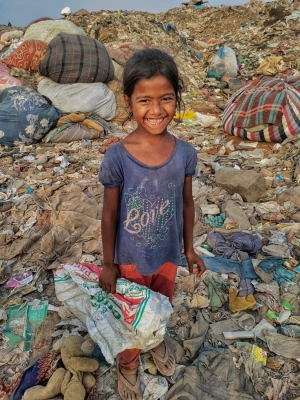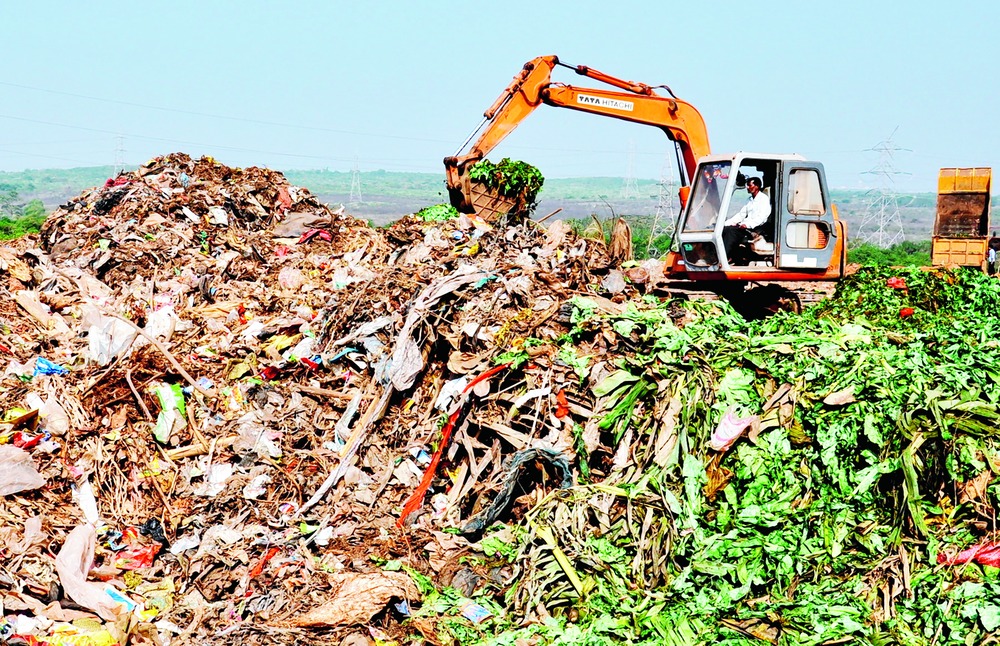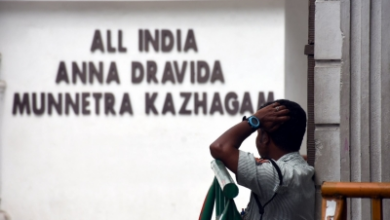Where Posterity Grows In Landfills! It is pan-India as in National Capital, ‘Beti Padhao’ Buries In Here

By D N Singh
Slogans be better be affixed on walls and sloganeering sound big during campaigns. This is what we see on the grounds made of litter-hills in the metros and in place like Delhi where many childhoods get singed by poisonous methane gas and many toxic fumes, the realities mock at Sarva Shiksha and Beti Padhao Beti Bachao Abhiyan.
Everything sound shrill and vacuous when we witness the little daughters, as the one in this picture. Yet she or many like her keep smiling being photographed standing amid endless expanse of landfills in the cities.
Today the world commemorates the World Day of Conservation Of bio-diversity, lets make sure no little heart runs the risk of in-taking the most unhealthy air in and finish as a chronic adult in the years to come.
Are We Hollowing A Progressive Present
This issue, however, is not new. In the past, many incidents of fire in landfill sites of Delhi have made headlines. Amid poisonous gases emanating from trash burning for several days together, not only are the people living in surrounding areas are troubled, but those working at these sites have little idea of the magnitude of hazard they are exposed to.
It is mostly children who work at these landfills, picking up plastic, iron and other metal pieces, and anything else of any value in the market. This is a means of livelihood for these children and their families.
Delhi has 3 large litter ‘hills’ at Okhla, Bhalswa, and Ghazipur landfill sites around which, slums have been built. There are 40-50 huts near each garbage hill which is home to children that work in these landfills.

Even while the garbage hill is on fire, these children continue to work as usual, knowing well that the gases released are toxic and suffocating. One can barely imagine how difficult it must be to choose between being hungry and breathing healthy. As the saying goes, the finest steel has to go through the hottest fire, but the future of these children in this fire has no end in sight.

Asif lives in Ghazipur slum. He had no other option but to collect waste even during the fire. He would set out to collect garbage at day-break, then sort it and sell it. His children would join him in this work and remain engaged from sun rise to sun set. This is how the family manages two square meals a day.
Hollowed Posterity
Toxic gases like methane and hydrogen sulfide keep emanating from the garbage. When they burn, carbon dioxide and carbon monoxide are also released. Methane is flammable.
A similar fire broke out at Bhalswa garbage mound and blazed for two weeks at stretch. The 12-year-old Satara residing there said that he studied till class VI but has been working as a waste-picker for the last two years. After the death of his parents, he quit studies and began working to run his household and get his sister married.
Neha, a resident of Ghazipur slum, said that she has been doing this work for the last 3 years. The 8-year-old Neha has never been to school. Her elder sister worked as a waste-picker earlier and Neha joined her at the garbage mound everyday, picking up iron and plastic. Neha wants to go to school but she could not because her family cannot afford the children’s education.
Ten-year-old Umar does not understand Hindi. He speaks Bengali. Three years back, his family came to Delhi. His uncle’s entire family also work as waste-pickers. No one in his family is educated, so no other work was available to them. Umar used to go to school earlier but he dropped out after coming to Delhi.

Many claims have been made by Delhi and Central governments regarding eradication of poverty, education, and health. Yet, 14-year-old Manju could never study, despite being very desirous of going to school because no school admitted her. Her entire family also is engaged in picking and sorting waste from sun rise to sunset.
Akram, too, is desirous of continuing school like many other children and studied till class VI in Bihar. His family is in Delhi for the last three months. He will return to his village after two months. This family comes to Delhi every year in summer and returns in the rainy season.
What a book has to do in their lives. When the day-break drives them to the landfills and the evenings force them to the litter whole-sellers for a price that can hardly fill one stomach.
These kids spend all day at the garbage dump and have remained too distant from books. Delhi and the Central government claim their respective figures. The Delhi government has announced the opening of 11 more schools in the Budget for the year 2022. This year, the maximum chunk of the Budget (Rs 16,278 crore) has been allocated for education. According to the ruling Aam Aadmi Party in Delhi, the standard of education in Delhi has improved in the last few years.
According to the Central government, for those who are deprived of school education due to poverty, under Sarva Shiksha Abhiyan, children between 6-14 years of age have a Fundamental Right to Education. The Ministry of Women and Child Development has also started many schemes to provide education to poor girls.
Opening up more schools and devising means of education for these children have so far not done enough to secure their future. The truth is that these children need the support of the society to undertake the journey from mountains of garbage to a school.
Inputs from Ians with picture courtesy






